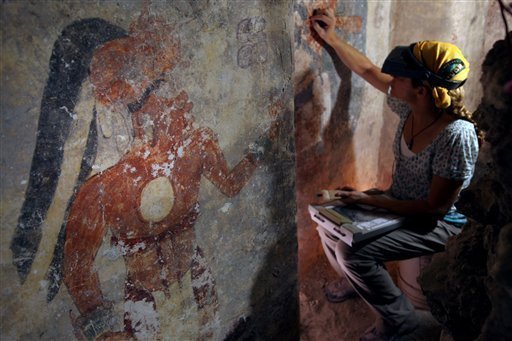Oldest Mayan calendar unearthed at Xultun archeological site


The oldest-known Mayan astronomical tables have been discovered at Xultun archeological site in Guatemala
The oldest-known Mayan astronomical tables have been discovered at Xultun archeological site in Guatemala, archaeologists announce.
Xultun includes the first known instance of Mayan art painted on the walls of a dwelling.
A report in Science says it dates from the early 9th Century, pre-dating other Mayan calendars by centuries.
Such calendars rose to prominence recently amid claims they predicted the end of the world in 2012.
The Mayan civilization occupied Central America from about 2000 B.C. until its decline and assimilation following the colonization by the Spanish from the 15th Century onwards. It still holds fascination, with many early Mayan sites still hidden or uncatalogued.
The ruins at Xultun were first discovered in 1912 and mapping efforts in the 1920s and 1970s laid out much of the site’s structure.


Archaeologists have catalogued the site’s features, including a 35m-tall pyramid, but thousands of structures on the 30 sq km site remain unexplored.
In 2005, William Saturno, then at the University of New Hampshire, discovered the oldest-known Mayan murals at a site just a few kilometres away called San Bartolo.
In 2010, one of Dr. William Saturno’s students was following the tracks of more recent looters at Xultun when he discovered the vegetation-covered structure that has now been excavated.
When Mayans renovated an old structure, they typically collapsed its roof and built on top of the rubble. But for some reason, the new Xultun find had been filled in through its doorway, with the roof left intact.
Dr. William Saturno, who is now based at Boston University, explained that despite it being under just a metre of soil today, that served to preserve the site after more than a millennium of rainy seasons, insect traffic and encroaching plant and tree roots.
“We found that three of the room’s four walls were well preserved and that the ceilings were also in good shape in terms of the paintings on them, so we got an awful lot more than we bargained for,” he said.
The excavation was carried out using grants from the National Geographic Society, which has prepared a high-resolution photographic tour of the room.
It measures about 2 m on each side with a 3 m, vaulted ceiling, and is dominated by a stone bench, suggesting the room was a meeting place.
The east wall features a number of seated figures, nearly life-sized, dressed in black and wearing elaborate headdresses similar to a bishop’s mitre.
They all look toward the north wall, on which a more elaborately dressed figure in orange holds a stylus in a hand outstretched toward a figure that Dr. William Saturno believes represented the king of Xultun.
“The seated figures that we see around them are involved in some narrative in which the king is being portrayed impersonating a Mayan deity and these guys are in attendance at that impersonation,” Dr. William Saturno explained.
The relevance of the figure with the stylus seems clear: “We think this room was used as a writing room, that it’s part of a complex associated with the work being done by Maya scribes.”
Perhaps most intriguing among the finds were several finds related to astronomical tables, including four long numbers on the east wall that represent a cycle lasting up to 2.5 million days.
The east wall is mostly covered by tabulations of black symbols or “glyphs” that map out various astronomical cycles: that of Mars and Venus and the lunar eclipses.
The wall also features red marks that appear to be notes and corrections to the calculations; Dr. William Saturno said that the scribes “seem to be using it like a blackboard”.
The Xultun find is the first place that all of the cycles have been found tied mathematically together in one place, representing a calendar that stretches more than 7,000 years into the future.
The Mayan numbering system for dates is a complex one in base-18 and base-20 numbers that, in modern-day terms, would “turn over” at the end of 2012.
But Dr. William Saturno points out that the new finds serve to further undermine the fallacy that this is tantamount to a prediction of the end of the world.
“The ancient Maya predicted the world would continue, that 7,000 years from now, things would be exactly like this,” he said.
“We keep looking for endings. The Maya were looking for a guarantee that nothing would change. It’s an entirely different mindset.”
Recent Posts
Happy New Year 2025: Sydney Welcomes New Year with Fireworks Display
Sydney has welcomed 2025 with a spectacular fireworks display - cheers erupted as the clock struck midnight…
Brad Pitt and Angelina Jolie Reach Divorce Settlement After 8 Years
Following an eight-year legal battle, Angelina Jolie and Brad Pitt have reached a divorce settlement,…
Former US President Jimmy Carter Dies at 100
Former President Jimmy Carter died on December 29 at the age of 100 after spending several…
Georgia: Outgoing President Salome Zourabichvili Refuses to Step Down After Mikheil Kavelashvili’s Inauguration
Georgia’s outgoing president Salome Zourabichvili refused to step down on December 29, saying she was…
Bald Eagle Officially Designated America’s National Bird After 250 Years
The bald eagle has been officially declared the national bird of the United States, after…
Kazakhstan Plane Crash: Dozens Survive Azerbaijan Airlines Plane Crash Near Aktau Airport
Dozens of passengers have survived a crash involving a plane carrying 69 people in Kazakhstan,…

